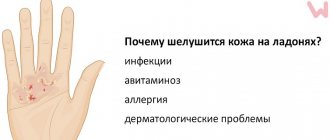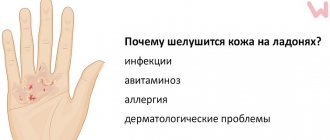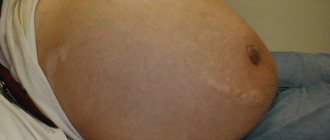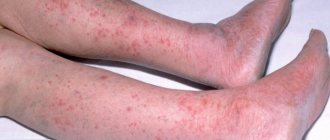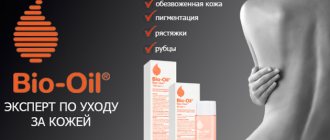Skin xerosis is an abnormal dryness of the upper layer of the skin caused by changes in the hydrolipid balance of the skin. It manifests itself as a dry, rough structure of the surface of the skin. The skin becomes cracked, inflamed, and infected. With the disease, the entire spectrum of pathological skin changes is observed: disturbances in sebum secretion, sweating, skin lipids, amino acid deficiency, and a feeling of discomfort. The condition is constantly accompanied by itching, which reduces the patient’s quality of life.
Dry skin: causes
The key cause of dry skin is the slow production of sebum, which leads to insufficient nutrition of the upper layer of cells (dermis). This deficiency may have hereditary causes or be caused by a number of external and internal factors. According to dermatologists
, at a young age, dry skin is hereditary, but in adulthood, insufficient pore secretion is caused by a variety of reasons.
All causes of dry skin on the body or individual areas can be divided into internal and external. External ones include:
- arid climate;
- dry air;
- exposure to too cold or too hot water;
- long tan;
- exposure to low air temperatures;
- improperly selected skin care products (too frequent use of soap, aggressive cleansers or procedures).
Internal reasons relate to the health of a person and his body as a whole, these include:
- dehydration: during diarrhea, fever, prolonged exposure to heat, etc.;
- hormonal disorders: menopause, diabetes, hypothyroidism and other endocrine diseases;
- impaired metabolism;
- prolonged stress;
- prolonged course of antibacterial treatment using antibiotics;
- overdose of vitamins (especially A and E);
- skin diseases (eczema, allergies, keratosis, psoriasis, dermatitis, etc.);
- unbalanced diet, mono-diets;
- bad habits;
- natural aging.
The causes of dry body skin directly affect treatment, because even the localization of injured areas can indicate a very specific factor that caused the disorder.
Dry skin in a baby in the first days of life is considered a variant of the norm, while the child’s body adapts to new living conditions outside the mother’s body. Imperfect sebum secretion systems cannot cope with the load in dry air, so dry spots may appear on the skin of a baby or uniform dryness of the entire skin, which can be felt in the palm of the hand.
Dry hand skin is most often caused by external factors: working with aggressive building mixtures, washing dishes without gloves, working on the ground or in the cold, overusing antibacterial soap and others that dry out the skin of the hands. In these cases, it is necessary to monitor the condition of the dermis in the folds between the fingers: dry hands caused by a lack of vitamins A, B and E can result in painful cracks in these areas that will have to be treated.
Dry scalp can be a hereditary factor - in this case, it will also be dry on the face and body. The main problem of dry scalp is unsightly dandruff and the threat of hair loss due to insufficient nutrition of the hair follicles. In addition to heredity, other reasons may contribute to dry scalp:
- unbalanced diet;
- incorrectly selected care series (shampoos, balms, masks, etc.);
- frequent coloring and perm;
- hormonal disorders;
- frequent styling using high temperatures (hot hair dryer, curling iron, flat iron) and fixing agents (varnish, gel, etc.);
- prolonged exposure to the open sun with your head uncovered;
- working in a room with dry air.
Many patients come to the dermatologist with the question: “Why is the skin on the elbows dry and dark?” In many cases, the reason lies in mechanical stress: prolonged work at a desk in an office or frequent hot baths. Although dry skin on the elbows can be a symptom of serious diseases:
- hypothyroidism: due to a slowdown in metabolism, the skin’s ability to regenerate deteriorates, as a result of which dead cells do not have time to exfoliate;
- iron deficiency anemia: lack of hemoglobin in the blood causes oxygen starvation of cells and impairs their viability;
- diabetes mellitus: a general malfunction of the endocrine system disrupts the nutrition of skin cells, causing it to become dry and thin;
- autoimmune and dermatological diseases, which result in dry patches on the skin.
Dry facial skin can be a hereditary factor, in which case, before the age of 20, a person receives many benefits: he has fewer problems with shine on his face, and is also less likely to suffer from acne during puberty. However, after 20, careful care and moisturizing of the skin will be required, otherwise early wrinkles will be the smallest problem that the patient may encounter.
With age, even those with normal skin experience dryness - this is a completely natural process caused by a slowdown in metabolism. These patients have access to numerous care products and cosmetic procedures that stimulate the cells of the upper layer of the skin.
Dry body skin can become due to both external and internal factors: prolonged tanning, working outdoors, improper care and hygiene products - all this can disrupt the functioning of skin cells and accelerate their death.
Dry skin on the feet can appear for a variety of reasons - from improperly selected shoes to vitamin deficiency or fungal disease. Such causes of dry skin on the legs must be identified and eliminated, otherwise painful cracks may soon appear on the affected area, the treatment of which will require a lot of time and effort.
The most common cause of dry skin on the feet is improper, often too tight, shoes. Pay attention to the height of the heel and the fullness of the model, and before purchasing, it is better to try it on in the evening, when your feet are slightly swollen after a day of work. Give preference to shoes made from natural materials with a leather insole - this will provide good ventilation and reduce the possibility of developing fungus, which can cause dry skin even on the lower legs.
Peeling hands
Many patients with a similar problem are ready to limit themselves to using a special nourishing cream. However, often this measure is not enough, especially since there are no sebaceous glands on the palms, which means that the natural protective barrier is relatively weak. So “amateur activity” in this area is undesirable. It is better to make an appointment with a dermatologist and ask how to treat dry skin on your hands.
Pay attention to factors that particularly affect the health of the epidermis:
- exposure to household chemicals and detergents;
- improper hygiene;
- frequent contact with hot water;
- influence of external factors.
Symptoms of dry skin
Symptoms of dry skin are specific and similar in different parts of the body:
- feeling of tightness;
- rough surface;
- excessive smoothness and shine;
- possible itching of the affected areas, redness;
- in some cases - cracking and bleeding, the appearance of small wounds covered with crusts.
If you notice similar symptoms, consult a doctor immediately. It is easier to prevent a disease than to deal with the consequences.
Nutrition for dry skin
If the skin is insufficiently moisturized and, as a result, it becomes dry and flaky, change your diet and menu. Get used to eating at the same time, avoid spicy, fatty, and sweet foods. This will have a beneficial effect on your skin and weight. about how to properly create a menu at the age of 40–45 in this article.
Dear women! If you are worried about dry skin on your hands and feet, don’t despair. It’s easy to get rid of this manifestation: with a systematic approach, you will need 1-2 courses of homemade masks or treatment from a doctor. The latter, as a rule, does not exceed 1–3 weeks. Have a good day!
Treatment for dry skin
Therapy for excessive dry skin will depend on both the location of the lesion and the age of the patient, the presence of concomitant diseases and allergic reactions.
Dry hand skin: causes and treatment
To eliminate dry hands and treat skin, a number of important protective measures must be taken:
- work with aggressive substances only in rubber or cotton gloves;
- in the cold season, wear warm gloves or mittens before going outside;
- lubricate your hands with sunscreen with UV filters;
- dry your hands after washing with a soft towel using blotting movements;
- use good quality household chemicals;
- balance the diet;
- pay attention to the amount of vitamins A, B and E consumed, and if necessary, take a multivitamin complex.
To treat dry hand skin, moisturizing and wound-healing medical creams and ointments are used. As an alternative, you can use folk recipes, including masks, baths and compresses with a wound-healing, moisturizing and nourishing effect on the skin.
Dry skin in a child
One of the causes of dry skin in infants may be a reaction to laundry detergents or clothing that is too stiff. To do this, it is recommended to use specialized powders for children that contain fewer aggressive and dangerous substances. High-quality ironing of all clothes from the wrong side will eliminate the remains of unrinsed detergents and make the surface of the fabric softer and smoother.
At the same time, it is necessary to use special products to moisturize and nourish delicate baby skin: creams, oils and emulsions are applied immediately after bathing, when the skin is cleansed and has absorbed the maximum of nutrients. Up to 3 months, pediatricians recommend using baby oils, regardless of skin condition; these products can be replaced with extra virgin olive oil, which contains only natural ingredients.
If, despite all the measures, the child’s skin remains dry, a consultation with a dermatologist and allergist will be required, who will help determine the cause of the disorder and select the appropriate treatment.
Dry scalp: what to do?
To eliminate dry skin and prevent hair loss, it is necessary to exclude all negative factors: wash your hair with warm water, dry your hair naturally at room temperature, do not comb wet hair. Adjusting your diet with the introduction of fish, vegetable oils and protein foods will help solve the problem of dry scalp. As emergency measures, you can use professional care products or folk recipes for wraps and masks with onions, eggs, oils or milk.
Dry skin on elbows: treatment
To treat dry skin on the elbows, it is necessary to identify and eliminate the internal cause of this disorder, that is, treat the underlying disease. As an auxiliary therapy, symptomatic treatment is used, aimed at improving the exfoliation of dead skin and softening its rough areas. The most popular traditional medicine recipes in this case are compresses made from sour cream with sunflower oil, a scrub made from honey with ground coffee and baths with warm milk.
What to do if very dry skin is peeling
What to do if your facial skin is very dry? First of all, consult a doctor who will conduct a comprehensive examination of the body. The condition of the skin on the face can be affected by factors such as:
- disorders of the gastrointestinal tract;
- diseases of the nervous system;
- diseases of the endocrine system;
- hypovitaminosis (especially lack of vitamins A, E and group B).
In these cases, without treating the underlying disease, careful facial care will only provide a temporary effect. Once you stop using actively moisturizing and nourishing products, your skin condition will worsen dramatically.
Your attending physician will tell you in detail what to do with dry skin, who will determine the true cause of the problem and select the appropriate treatment. It will be useful to follow general recommendations: minimize the aggressive influence of environmental factors and carefully select products for daily care and cleansing.
Traditional medicine offers a number of very effective recipes for masks and washes that will help in the fight against dry skin on the face. Most of them include vegetable oils, herbal infusions, fresh fruits and vegetables, and egg yolk - a source of tons of nutrients.
Dry body skin: treatment
What to do with very dry body skin? To begin with, eliminate possible external negative factors and review your daily diet, paying attention to a sufficient amount of seafood, nuts, dairy, fish, broccoli and vegetable oils.
If following a diet and protecting yourself from external negative factors do not help correct the situation, you will have to consult a dermatologist - most likely, dry skin on the body is caused by one of a number of diseases that need to be diagnosed and treated.
Traditional medicine recipes in the fight against dry skin can only be used after consultation with your doctor. These can be honey peels, baths with a decoction of herbs and seeds, masks and applications of fruits and vegetable oils.
Dry skin on legs: treatment
What to do with dry skin on your feet? In addition to eliminating the cause, use foot creams that contain moisturizing and moisture-retaining components. Among folk recipes, you can use masks with fruits, vegetables or castor oil - the nutrients from them will have a beneficial effect on damaged skin.
Dry skin on the heels can cause quite serious and painful cracks, what to do with such problems? Recipes used to treat similar cracks on the hands are suitable here: compresses with apple cider vinegar or a mixture of glycerin and ammonia.
Differences between dermis types
To choose the right caring cosmetics, you need to know what you are dealing with and what specific features you have. There are four types in total:
- dry;
- fat;
- combined;
- normal.
These characteristics are determined by genetics, but lifestyle, environmental factors and health play a huge role. To find out which epidermis you have, do a simple test. Clean your face with a mild cleanser, pat dry with a towel, and do not apply any cosmetic creams or serums. Assess the external shine after about an hour.
First type
After washing your face without using moisturizing ingredients, you may feel some tightness. When you blot with matting wipes, you notice that there are no traces of grease left on them. This means that you have dry skin on your body - the reasons, as we have already said, lie in genetics, but improper care and lifestyle usually aggravate the problems.
As a rule, the basis for their manifestation may be a lack of lipids; the protective layer on the surface becomes thinner and becomes permeable. Unfortunately, such features lead to the fact that with age, deeper and more pronounced wrinkles appear on the face, as the epidermis loses its plasticity and ability to replenish volume. Creases occur more easily and last longer.
Second type: normal
In the modern world, where we are influenced by dozens of unfavorable factors, it is not so easy to meet a person with this type. Even if the sebaceous glands are naturally balanced, many circumstances, including health conditions and the use of cosmetics, can disrupt the harmony. And in this case, the doctor hears the question, why is the skin on the face very dry? Normally, sebum secretion occurs evenly and there is no shine. As a rule, the pores are not enlarged, small, blood circulation is good, the complexion is even, the texture is smooth and silky, there is no inflammation or acne. The epidermis is not sensitive, but with age it usually becomes denser, easily injured, itching and peeling occur, areas whose condition causes concern. Then patients turn to a dermatologist or cosmetologist with the question of how to get rid of dryness.
Third type: fat
If, after performing a home test, you see that the cleaned surface begins to shine within an hour, and pronounced traces of grease remain on the matting paper, then you have this type. The reasons for increased sebum production, in addition to congenital characteristics, may be:
- hormonal imbalance;
- use of certain drugs;
- stress;
- cosmetics that lead to the formation of comedones, etc.
Danger
If dry skin is not given timely attention, the consequences can be very different. In some cases, the disease may not progress, but in most patients, sooner or later, dry skin begins to itch, crack and become inflamed. The danger of these situations is:
- risk of infection of cracks and development of inflammatory processes;
- risk of increasing the affected skin area;
- the risk of developing complications of the underlying disease if dry skin is a symptom of another disorder;
- constant discomfort of the patient from a feeling of tightness and itching.
Prevention
To prevent dry skin, it is necessary to eliminate or reduce the impact of possible negative factors:
- wear hats to protect the scalp from drying out;
- use sunscreen not only on the beach, but also while walking outdoors in the city or on a picnic;
- regularly use moisturizing creams designed for a specific skin type;
- Wash children's underwear with hypoallergenic detergents and rinse thoroughly;
- undergo regular preventive examinations for timely diagnosis of diseases affecting the condition of the skin.
This article is posted for educational purposes only and does not constitute scientific material or professional medical advice.
How to care for dry skin on the face, legs, arms and body in winter: a few general recommendations
So, we have dealt with the main causes of the problem, now it is time to summarize and derive several rules that are mandatory for everyone.
To ensure that your skin always looks great, is soft and soft, you need to:
- Drink at least 1.5 liters of fresh water daily. Tea, coffee, juices and compotes do not count.
- Always wash your face only with water at room temperature.
- Forget about using alcohol-containing lotions, shower gels and shampoos.
- Regularly humidify the indoor air.
- Wear clothes made from natural fabrics and always protect your hands and head from frost.
- Regularly use natural cosmetics and do simple procedures at home. I will cover this point in more detail.


